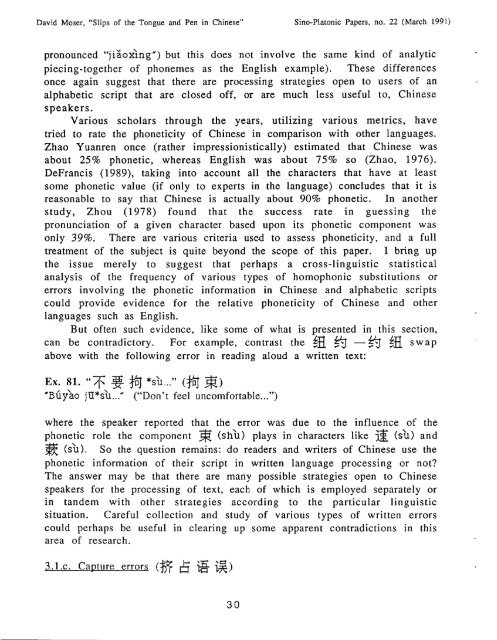Slips of the Tongue and Pen in Chinese - Sino-Platonic Papers
Slips of the Tongue and Pen in Chinese - Sino-Platonic Papers
Slips of the Tongue and Pen in Chinese - Sino-Platonic Papers
Create successful ePaper yourself
Turn your PDF publications into a flip-book with our unique Google optimized e-Paper software.
David Moser, "<strong>Slips</strong> <strong>of</strong> <strong>the</strong> <strong>Tongue</strong> <strong>and</strong> <strong>Pen</strong> <strong>in</strong> Ch<strong>in</strong>ese" S<strong>in</strong>o-<strong>Platonic</strong> <strong>Papers</strong>, no. 22 (March 199 1 )<br />
pronounced "ji'iox~ng') but this does not <strong>in</strong>volve <strong>the</strong> same k<strong>in</strong>d <strong>of</strong> analytic<br />
piec<strong>in</strong>g-toge<strong>the</strong>r <strong>of</strong> phonemes as <strong>the</strong> English example). These differences<br />
once aga<strong>in</strong> suggest that <strong>the</strong>re are process<strong>in</strong>g strategies open to users <strong>of</strong> an<br />
alphabetic script that are closed <strong>of</strong>f, or are much less useful to, Ch<strong>in</strong>ese<br />
speakers.<br />
Various scholars through <strong>the</strong> years, utiliz<strong>in</strong>g various metrics, have<br />
tried to rate <strong>the</strong> phoneticity <strong>of</strong> Ch<strong>in</strong>ese <strong>in</strong> comparison with o<strong>the</strong>r languages.<br />
Zhao Yuanren once (ra<strong>the</strong>r impressionistically) estimated that Ch<strong>in</strong>ese was<br />
about 25% phonetic, whereas English was about 75% so (Zhao, 1976).<br />
DeFrancis (1989), tak<strong>in</strong>g <strong>in</strong>to account all <strong>the</strong> characters that have at least<br />
some phonetic value (if only to experts <strong>in</strong> <strong>the</strong> language) concludes that it is<br />
reasonable to say that Ch<strong>in</strong>ese is actually about 90% phonetic. In ano<strong>the</strong>r<br />
study, Zhou (1978) found that <strong>the</strong> success rate <strong>in</strong> guess<strong>in</strong>g <strong>the</strong><br />
pronunciation <strong>of</strong> a given character based upon its phonetic component was<br />
only 39%. There are various criteria used to assess phoneticity, <strong>and</strong> a full<br />
treatment <strong>of</strong> <strong>the</strong> subject is quite beyond <strong>the</strong> scope <strong>of</strong> this paper. I br<strong>in</strong>g up<br />
<strong>the</strong> issue merely to suggest that perhaps a cross-l<strong>in</strong>guistic statistical<br />
analysis <strong>of</strong> <strong>the</strong> frequency <strong>of</strong> various types <strong>of</strong> homophonic substitutions or<br />
errors <strong>in</strong>volv<strong>in</strong>g <strong>the</strong> phonetic <strong>in</strong>formation <strong>in</strong> Ch<strong>in</strong>ese <strong>and</strong> alphabetic scripts<br />
could provide evidence for <strong>the</strong> relative phoneticity <strong>of</strong> Ch<strong>in</strong>ese <strong>and</strong> o<strong>the</strong>r<br />
languages such as English.<br />
But <strong>of</strong>ten such evidence, like some <strong>of</strong> what is presented <strong>in</strong> this section,<br />
can be contradictory. For example, contrast <strong>the</strong> $3 E[ -5 swap<br />
above with <strong>the</strong> follow<strong>in</strong>g error <strong>in</strong> read<strong>in</strong>g aloud a written text:<br />
Ex. 81. "F $ fl (m *ss'u..." g)<br />
a~Gy'i~ j~*ss'u ..." ("Don't feel uncomfortable...")<br />
where <strong>the</strong> speaker reported that <strong>the</strong> error was due to <strong>the</strong> <strong>in</strong>fluence <strong>of</strong> <strong>the</strong><br />
phonetic I -ole <strong>the</strong> component (shb) plays <strong>in</strong> characters like 2 (sb) <strong>and</strong><br />
(st). So <strong>the</strong> question rema<strong>in</strong>s: do readers <strong>and</strong> writers <strong>of</strong> Ch<strong>in</strong>ese use <strong>the</strong><br />
phonetic <strong>in</strong>formation <strong>of</strong> <strong>the</strong>ir script <strong>in</strong> written language process<strong>in</strong>g or not?<br />
The answer may be that <strong>the</strong>re are many possible strategies open to Ch<strong>in</strong>ese<br />
speakers for <strong>the</strong> process<strong>in</strong>g <strong>of</strong> text, each <strong>of</strong> which is employed separately or<br />
<strong>in</strong> t<strong>and</strong>em with o<strong>the</strong>r strategies accord<strong>in</strong>g to <strong>the</strong> particular l<strong>in</strong>guistic<br />
situation. Careful collection <strong>and</strong> study <strong>of</strong> various types <strong>of</strong> written errors<br />
could perhaps be useful <strong>in</strong> clear<strong>in</strong>g up some apparent contradictions <strong>in</strong> this<br />
area <strong>of</strong> research.<br />
3. I .c. Capture errors (fi & ig)
















